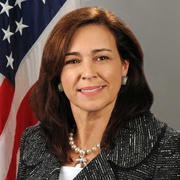
German Defense Minister Von Der Leyen meets U.S. Defense Secretary Chuck Hagel at the Munich Security Conference in Germany, Feb. 01, 2014. DOD photo by U.S. Marine Corps Sgt. Aaron Hostutler
Moving U.S.-German Relations Past the NSA Headlines
Despite recent headlines about Snowden and spying, U.S.-German interests remain in lockstep from Afghanistan to Syria, Iran and now the Ukraine. By Tara Sonenshine
Relationships between countries these days are far more complex than just issues of security or traditional diplomacy. Take the case of the United States and Germany. Recent strains over surveillance, privacy, data protection and Edward Snowden have led to a mistaken sense that our two nations are drifting apart. A new report by Reuters suggests that the National Security Agency has stepped up surveillance of German ministers in lieu of spying on its president.
But despite these bumps in the road, the U.S.-German relationship appears sturdy across a range of issues from hard power to soft power, managing to move past the vicissitudes of daily politics.
As Europe has taken more responsibility for its own security, Germany has taken steps to increase its military engagement around the world despite public resistance. (Germany has a huge arms industry and export business.) Recently, the German government decided to extend deployment of Patriot missiles in Turkey as part of the NATO mission to contain Syria’s conflict. Regarding Iran, Germany added its support to the permanent five nations of the United Nations Security Council to advance a nuclear agreement that would include lifting some European sanctions. Most recently, Berlin played a prominent role in trying to broker an agreement between Ukrainian opposition leaders and President Viktor Yanukovych. The U.S. is going to need Germany and all of Europe to remain united in pushing back on Russian temptations to intervene militarily in the Ukraine crisis. Lastly, for Afghanistan to succeed in 2015, the U.S. will rely on Germany and NATO to stay engaged.
Beyond military and foreign policy ties, U.S. and German cultural relations remain strong. Nearly one quarter of all Americans trace their ancestry to Germany. American cities like Anaheim, California; Manheim, Pennsylvania; Bismarck, North Dakota; and Frankenmuth, Michigan, trace their roots to Germany. Goethe Institutes of culture operate in many U.S. cities including New York, Atlanta, Chicago, Boston and Washington, D.C. The German-American Fulbright Program is one of the largest bi-national educational exchange programs in the world.
According to the 2013 report on international educational exchange, “Open Doors,” Germany saw the highest increase of U.S. students enrolled in degree programs of all the non-English speaking European countries. The number of U.S. students seeking degrees at German universities increased 24% between 2010 and 2012. The highest number of U.S. degree students in Germany continues to be in the humanities, but the strongest growth over the last three years has been in the fields of business and management, mathematics and computer science. Close to 10,000 German students are on American campuses each year. American students choose Germany as a popular destination with popularity increasing for programs like IES Abroad in Berlin or German Marshall Fund projects.
In a world driven by a 24-hour news cycle it is tempting to let the political debate of the moment -- like spying -- define what really are deep-rooted and complex international relationships. But if you look beyond the headlines at cultural relations, educational exchanges, financial interactions and people-to-people diplomacy, there is little reason to doubt the strength of the key U.S.-German transatlantic relationship. It behooves both American and German publics to keep the bridge between our nations fortified as we face common threats and challenges in the future.





